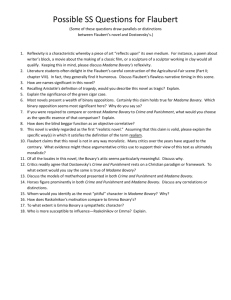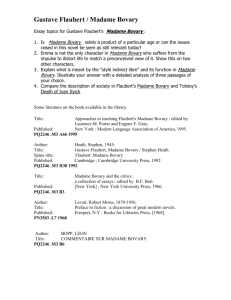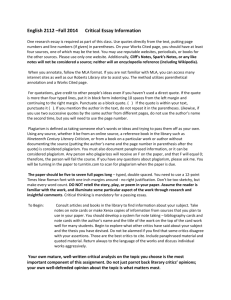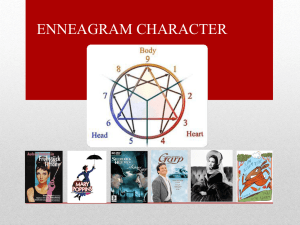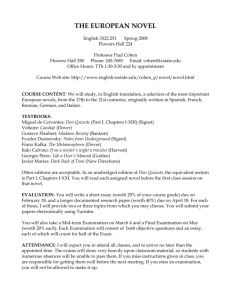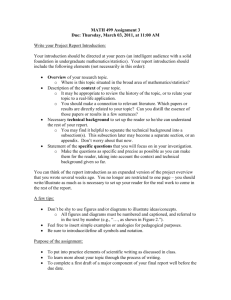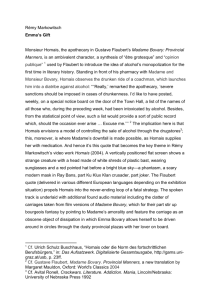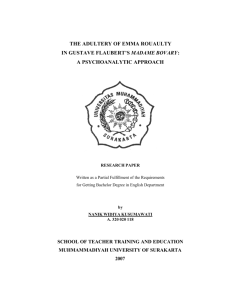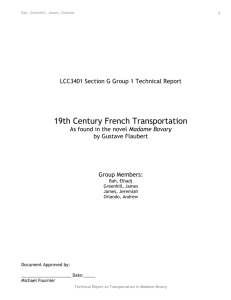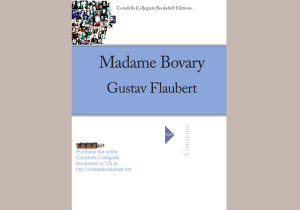Reading Madame Bovary
advertisement
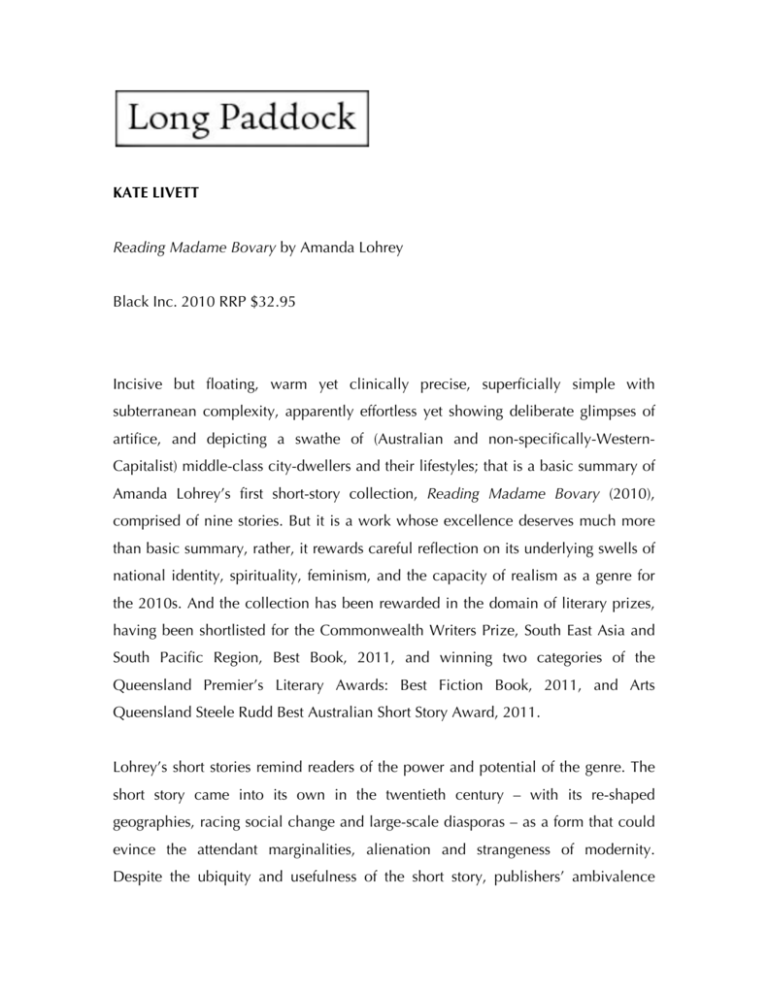
KATE LIVETT Reading Madame Bovary by Amanda Lohrey Black Inc. 2010 RRP $32.95 Incisive but floating, warm yet clinically precise, superficially simple with subterranean complexity, apparently effortless yet showing deliberate glimpses of artifice, and depicting a swathe of (Australian and non-specifically-WesternCapitalist) middle-class city-dwellers and their lifestyles; that is a basic summary of Amanda Lohrey’s first short-story collection, Reading Madame Bovary (2010), comprised of nine stories. But it is a work whose excellence deserves much more than basic summary, rather, it rewards careful reflection on its underlying swells of national identity, spirituality, feminism, and the capacity of realism as a genre for the 2010s. And the collection has been rewarded in the domain of literary prizes, having been shortlisted for the Commonwealth Writers Prize, South East Asia and South Pacific Region, Best Book, 2011, and winning two categories of the Queensland Premier’s Literary Awards: Best Fiction Book, 2011, and Arts Queensland Steele Rudd Best Australian Short Story Award, 2011. Lohrey’s short stories remind readers of the power and potential of the genre. The short story came into its own in the twentieth century – with its re-shaped geographies, racing social change and large-scale diasporas – as a form that could evince the attendant marginalities, alienation and strangeness of modernity. Despite the ubiquity and usefulness of the short story, publishers’ ambivalence toward the genre was a problem even in the century during which the form blossomed: the not-yet-famous John Steinbeck commented in the 1930s that publishers were “afraid of short stories unless the writer has a tremendous name.”i We witnessed a flourishing of the genre in Australia in the 1970s and 1980s followed by another period of publishing anxiety and, no doubt related, a sense of readers’ tiredness with short fiction. Fortunately, the last few years have seen a return of the short story – consider the reception of Nam Le’s The Boat (2008) – and Lohrey’s collection heralds a revived awareness of its radical potential. Reading Madame Bovary conveys a strong sense of contemporary middle-class, mostly urban Australian culture. The details that drive the events and the texture of Lohrey’s stories are recognisable in their particular arrangements as pressing a central nerve of urban Australia, at least, though their reach extends to the Western middle-classes more broadly. This relation between Australian particularities and their extensions is built in to the very fabric of the fiction. The third story ‘Ground Zero’ is a case in point. The issue of white middle-class guilt over Aboriginal genocide and the desperate conditions of Australian Indigenous people in the present lies between the words of this story. However, as the loaded title of the story suggests, Lohrey identifies this fear and hatred of the ‘other’ as an operation inherent in western ideology, and a legacy of colonial projects. A middle-class white male protagonist’s mid-life onset of a permanent feeling of rage culminates in his physical assault on an Aboriginal man during a petty dispute. Following this, the protagonist, out of sheer desperation, begins to attend a meditation workshop. The story ends with the completion of the workshop, and the protagonist’s realisation that he is going to need to suspend intellectual scepticism, as his rage – an abstract emotional state – can only be healed by a different kind of abstract condition, that of faith. A similar examination of modern life and its relationship to spiritual faith is seen in the final story of the collection, ‘Letter to the Romans’. In this story a university student’s conversion from ‘normal’ middle-class teenager to evangelical Christian is the precipitator of the narrative. Many university lecturers in Australia today would recognise this young man’s identity shift: partially explainable as a ‘global’ phenomenon of younger generations’ return to fundamentalist religion, but also inextricably connected to Australia’s ‘local’ culture and society. The story does not make explicit the young man’s reasons for turning to religion, but rather leaves that fictional space open for the reader. Lohrey invites the reader to bring their own knowledge of the Australian cultural context to this story – the frequent newspaper articles telling us of young people’s shock at the rampant disappointments of capitalism, or that express other young people’s fear of the contemporary drinking/drugs culture in Australia, which for some is simply too violent and excessive to negotiate without an equally forceful resistance. The dilemma is recognisable as both specifically Australian, and simultaneously global, in concert with America’s relationship with religion. Like recent trends of teenage American girls who swap ‘promise rings’ with their fathers (swearing Virginity until marriage as a ‘promise’ made to their father) and the rise of the Hillsong Church. Lohrey’s ‘Letter to the Romans’ depicts, again through inference, the ‘rebellion’ that the young man’s conversion enacts against the force of Australia’s middle-class secularism. This secularism is embodied in the noncomprehension and dismay of the older two characters to the young man’s conversion: the student’s mother, and one of the student’s university lecturers. The Bible, however, alongside experimental personal interactions, constitutes this story’s central investigation into ‘the meaning of life’ – ironically not the life of the young man, but of his mother and his university lecturer. Lohrey is examining the ways in which people approach the excess that secularism cannot accommodate, the dimension of the spiritual – or even just the meaningful – that persists in a myriad of forms. Realism – complemented and undermined by accompanying non-realist elements – has been the predominant receipt of the short story since its beginnings by Edgar Allan Poe in the 19th century, and like the famous short-storyists Anton Chekhov, Guy de Maupassant, Henry Lawson, Barbara Baynton, Alice Munro, and indeed, Gustave Flaubert, Lohrey’s Reading Madame Bovary is steadfastly realist. While it comes with the attendant advantage of readers’ easy acceptance, realism nevertheless has its disadvantages, most of which spring from its very claim to be the genre of fiction which most nearly represents ‘reality’. One of the submerged rocks of realism that many writers strand themselves upon is the almost embarrassingly fictional nature of real life itself: its clumsy symbolism; its unlikely, artificial-sounding coincidences; and its tide of texts – visual, written, aural – that weave us 24/7 into a reality that can never be separated from representation. Lohrey not only negotiates these problems, but masters them and in doing so brings them into her own service. Texts – that is, novels, piano sonatas, philosophical tracts, everyday advertising information – are crucial in nearly all of these stories. The question that Lohrey is raising is one that preoccupied the twentieth-century, and in the postmodernism of the final years of last century was at its most ironic and fractious: what is the relationship between these forms of representation, these written/visual texts, and what we experience as ‘reality’, the experience of living? There are texts in every story here: from the banal corporate training program brochure in ‘Primates’, to Flaubert’s Madame Bovary in the eponymous story, to the philosophies of Maria Montessori and Friedrich Froebel in ‘Freedom, Order and the Golden Bead Material’, an absent character’s sport and nutrition diary in ‘Perfect’, the Sydney Piano Competition, on ABC FM, in ‘The Art of Convalescence’, and the Bible, in ‘Letter to the Romans’. The inclusion of direct quotes and/or summaries and discussions of such texts is handled, variously, with smooth sleight-of-hand, ironically, thoughtfully, and with deliberation. In each different case there is a tricky moment, more and less prominent depending on the story, in which the reader teeters between suspension-of-disbelief and jarring ejection from this ‘world’ of the story. But Lohrey deftly ensures that if the reader falls, it is onto soft ground: an awareness of the artificiality of realism, of all language, in its claims to be reality. Language, like reality itself, both is and isn’t ‘reality’. The moments when these connections are made ride a fine line between the believable and the constructed/artificial, the moment when it is possible to see the machinations of the writer’s brain, and the moment when the reader’s suspension of disbelief in the ‘reality’ of the story is suddenly broken. Actually, this is the most contemporary of moves, a dexterously accomplished connection that does not sink the reader, but hums along as a background reminder that as real as these stories feel – and they feel very real to a middle-class reader living in Sydney – they are accumulations of words. Lohrey also approaches and defeats the problem of life’s annoyingly clichéd symbolism. Tropes are ‘set-pieces’ or scenes or ideas or sometimes even symbols that are so often used in the culture that they become almost self-parodic. Unfortunately, such tropes arise precisely because of their persistence in ‘life’. They are common because they are common. Thus, to avoid them in art is also to avoid an aspect of life. However, because they are obvious and tired, for any writer to take them on is a massive call. But Lohrey takes them on and triumphs, refashioning them so as to stun the reader with their relevance, their sense of ‘truth’. A corporate team holding a meeting at the Zoo, with a window into the primates cage; a bored young woman reading Madame Bovary and identifying herself as behaving just like the heroine of the novel; a middle-aged man in a midlife crisis attending meditation classes; a bourgeois woman obsessed with dieting and exercise; a woman with cancer treated impersonally by a bereft medical system; infighting amongst hippies in a commune; the erotics of an affair conducted once a week in a hotel room. Every single one of these could be called a ‘trope’ of contemporary life and literature: a ‘set-piece’ that feels immediately familiar to the reader. The problem with tropes is that they are not original. They are by definition worn-out, second-hand, already used so many times that they have been leeched of all particularity. It is a Herculean task to put the particularity back into a trope, as its power lies in its basic overall shape, and it is that basic shape that tends to capture and hold the reader’s attention. What the great writer or artist can do is to re-present these representations, to recast these banal symbols and to highlight the particularities and specificities that actually attend them in each of their individual appearances in ‘real life’. As such, Reading Madame Bovary is not only the product of a courageous writer, but a supremely accomplished one. Only the best writers can achieve such a delicate balance of what we think of as obvious and therefore dismiss as cliché, and the sense that these clichés are the portal to the truths of our contemporary culture and society, of our individual lives. Lohrey is a great writer in her ability to render all of this. She will, like the author of Madame Bovary, be regarded as a writer who scored out, sentence by beautifully-cast sentence, the reality of this moment in our society. Reading Madame Bovary is a feminist work, in the contemporary formulation of feminism, which acknowledges the complexity of women’s subjectivities as both desired and desiring subjects: mothers, wives but also career women and educated, inquiring and reflective members of modernity, striving – as many men have always been given the right to do – to understand themselves and others and the ‘meaning of life’ within this western capitalism we call home. As feminists have argued for decades, it is both women and men who benefit from feminism’s project of de-naturalising gender and sexuality. Thanks to feminism, both genders are released from the fear of the many ways in which they seem to daily ‘fail’ at being effortlessly good at their ‘natural’ (‘biological’) gender roles. Instead, these characteristics and behaviours of gender are finally understood as socially and culturally produced structural positions. Of course, as people we don’t experience these structural issues in the way that that word would imply – impersonal, dry, rational. Each individual has a personal relationship to the structural demands and expectations of gender, and each has embraced, resisted or complexly negotiated such behaviours, demands, and roles in different ways. This is the achievement of the appropriately long first story, ‘Primates’, and it is what Reading Madame Bovary, as a whole collection, is engaged in: the patient, poetic, teasing out of the unexpected and infinitely complicated ways in which lives are lived in relation to the structures that proffer and perpetuate our gender and sexuality, our relationships with others, and our experience of the spiritual. i Roggenkamp, Karen. ‘The Short Story Cycle and Western Gothic in The Pastures of Heaven.’ Steinbeck Review. 4.1:(2007), 18-31.p.21
